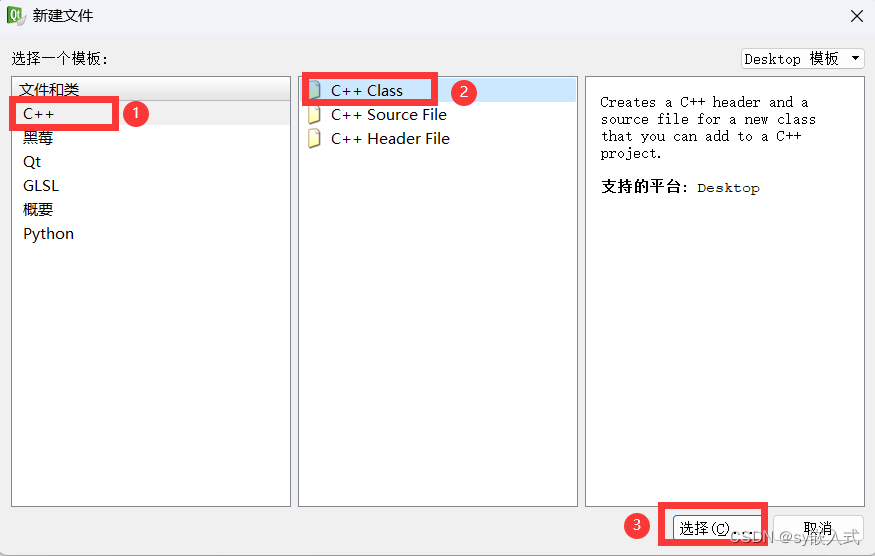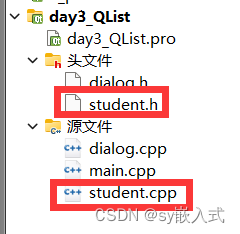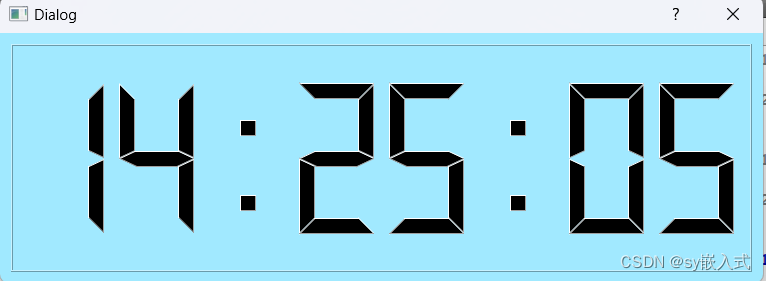Qt--QString字符串类、QTimer定时器类
目录
1. QString 字符串类
dialog.cpp
2. 容器类
2.1 顺序容器 QList
示例代码:
student.h
student.cpp
dialog.h
dialog.cpp
运行结果:
2.2 关联容器 QMap
示例代码:
dialog.h
dialog.cpp
运行结果:
3. Qt类型
3.1 跨平台数据类型
3.2 QVariant 统一数据类型
4. QDateTime 日期时间类
dialog.h
dialog.cpp
运行结果:
5. QTimer 定时器类
示例代码:
dialog.ui
dialog.h
dialog.cpp
运行结果:
1. QString 字符串类
QString是Qt中的字符串类,与C和C++不同的是,Qt的字符串使用Unicode编码。每一个字符使用一个16位的QChar,而不是之前8位的char,所以Qt处理中文没有问题,并且每个中文算作一个字符。
Qt是基于C++的开发框架,因此很多类会尽可能地兼容C++的API,QString支持绝大多数std::string的API,例如append、size、length、at、push_back等。除此之外,也有修改和新增的部分。
对于QString类的API,可以通过认识常用的英文单词查询文档使用。

dialog.cpp
#include "dialog.h"Dialog::Dialog(QWidget *parent): QDialog(parent)
{//支持多国语言QString text="αβγあいうえおАБВ";qDebug()<<text;qDebug()<<"字符串长度:"<<text.size();qDebug()<<text.length();qDebug()<<text.count();//int--->QString//参数1:要转换的数字 参数2:进制, 默认十进制text=QString::number(12,16);//cqDebug()<<"数字转换为字符串:"<<text;//向后追加text.setNum(12,16).append("哈哈哈");text.push_back("g");qDebug()<<"向后追加:"<<text;//向前追加text.prepend("e");text.push_front("d");qDebug()<<"向前追加:"<<text;text.insert(0,"a");qDebug()<<"插入元素"<<text;//移除 下标从0开始text.remove(1,4);qDebug()<<"移除后:"<<text;//替换text="Say yes!";text.replace(4,3,"no");qDebug()<<"替换:"<<text;//分割text="a,b,c";QStringList list=text.split(",");qDebug()<<"以逗号分割:"<<list;//QString-->int// int toInt(bool * ok = 0, int base = 10) const//参数1:表示是否转换成功 参数2:进制,默认十进制//返回值:转换的结果,0表示失败text="12";bool result;//转换是否成功int i=text.toInt(&result);qDebug()<<"是否成功:"<<result;qDebug()<<i;
}Dialog::~Dialog()
{}
2. 容器类
C++的STL容器类已经不适用于Qt的环境,因为Qt重新实现了部分容器类,据官方所说,Qt的容器类更加轻巧、安全和易于使用。Qt对这些容器类进行存储优化,可以使生成的exe可执行文件的体积减小,这些容器类是线程安全的,支持同时被多个线程进行只读访问,几乎支持C++的STL容器类的API,并在此基础上进行了扩充。
2.1 顺序容器 QList
先创建一个自定义的C++类,然后使用QList存储这个类的对象。
在Qt中创建一个自定义的C++类的操作步骤如下:
1. 在Qt Creator中选中项目名称,鼠标右键,点击“添加新文件”。
2. 在弹出的窗口中,按照下图所示进行操作。


3. 在弹出的窗口中,先给类命名(主题使用大驼峰命名法,即所有单词的首字母大写),然后点击“下一步”。
4. 在项目管理界面直接点击完成。可以看到在项目中已经有对应的头文件和源文件了。

QList除了支持C++的迭代器以外,还支持Java的迭代器,对应关系如下。
| C++迭代器 | 等效的Java迭代器 |
| QList::const_iterator | QListIterator |
| QList::iterator | QMutableListIterator |
QStringList类基本等同于QList
示例代码:
student.h
#ifndef STUDENT_H
#define STUDENT_H
//引入头文件
#include<QString>class Student
{
public:Student(QString,int,QString);QString getName() const;void setName(const QString &value);int getAge() const;void setAge(int value);QString getMajor() const;void setMajor(const QString &value);private:QString name;int age;QString major;
};#endif // STUDENT_H
student.cpp
#include "student.h"Student::Student(QString name,int age,QString major):name(name),age(age)
{this->major=major;
}QString Student::getName() const
{return name;
}void Student::setName(const QString &value)
{name = value;
}int Student::getAge() const
{return age;
}void Student::setAge(int value)
{age = value;
}QString Student::getMajor() const
{return major;
}void Student::setMajor(const QString &value)
{major = value;
}dialog.h
#ifndef DIALOG_H
#define DIALOG_H#include <QDialog>
//头文件
#include<QList>
#include"student.h"
#include<QDebug>class Dialog : public QDialog
{Q_OBJECTpublic:Dialog(QWidget *parent = 0);~Dialog();
};#endif // DIALOG_H
dialog.cpp
#include "dialog.h"Dialog::Dialog(QWidget *parent): QDialog(parent)
{//创建一个QList对象QList<Student> stu;Student s1("张三",18,"计算机应用技术");Student s2("李四",20,"电子信息工程");Student s3("王五",21,"计算机科学与技术");Student s4("赵六",19,"电子工程技术");Student s5("玛丽",23,"计算机应用技术");Student s6("杰克",24,"计算机科学与技术");//增加元素stu.push_back(s1);//向后追加stu.append(s2); //向后追加stu.push_front(s3);//向前追加stu<< s1<<s2<<s3;//连续追加//在第二个位置插入元素//参数1:位置//参数2:元素值stu.insert(1,s4);//删除元素stu.pop_back();//删除最后一个元素 -->removeLast()stu.pop_front();//删除第一个元素 -->removeFirst()stu.removeAt(3);//删除第n个元素//int QList::removeAll(const T & value) 删除所有相同元素//bool QList::removeOne(const T & value) 删除第一个相同的元素//更新元素stu[1]=s5;//参数1:元素位置//参数2:更新的位置stu.replace(2,s6);for(int i=0;i<stu.count();i++){Student s=stu.at(i);//更高效qDebug()<<s.getName()<<s.getAge()<<s.getMajor();}qDebug()<<"---------C++ STL迭代器-------------";//for(QList<Student>::const_iterator it=stu.begin();it!=stu.end();it++){Student s=*it;qDebug()<<s.getName()<<s.getAge()<<s.getMajor();}qDebug()<<"---------Java迭代器----------------";//Java迭代器构造函数,参数为容器对象QListIterator<Student> it(stu);while(it.hasNext())//判断后续有无有效元素{//向后移动并取出Student s=it.next();qDebug()<<s.getName()<<s.getAge()<<s.getMajor();}}Dialog::~Dialog()
{}
运行结果:

2.2 关联容器 QMap
关联容器的元素是以键值对的方式存在的,键表示数据的名称(通常使用字符串类型),值表示数据的本身(支持任何类型)。可以通过键来找到对应的值,关联容器是没有顺序的。
QMap除了支持C++的迭代器以外,还支持Java的迭代器,对应关系如下。
| C++迭代器 | 等效的Java迭代器 |
| QMap::const_iterator | QMapIterator |
| QMap::iterator | QMutableMapIterator |
示例代码:
dialog.h
#ifndef DIALOG_H
#define DIALOG_H#include <QDialog>
#include<QDebug>
#include<QMap>
class Dialog : public QDialog
{Q_OBJECTpublic:Dialog(QWidget *parent = 0);~Dialog();
};#endif // DIALOG_H
dialog.cpp
#include "dialog.h"Dialog::Dialog(QWidget *parent): QDialog(parent)
{QMap<QString,int> map;map["身高"]=180;map["年龄"]=18;map["体重"]=97;map["性别"]=1;//参数1:键//参数2:值map.insert("体重",90);//重新赋值//删除元素//参数:键//返回值:删除的键值对数量 返回0失败qDebug()<<map.remove("性别");//1qDebug()<<map.remove("性别");//0if(!map.contains("身高"))//修改map["身高"]=165;elseqDebug()<<"身高键值对已存在,无法修改!";if(map.contains("身高"))//取出qDebug()<<map["身高"];//不存在返回0//参数1:键//参数2:如果取不到的默认值 自设默认值为-1qDebug()<<map.value("体重2",-1);qDebug()<<"------支持直接输出-----------";qDebug()<<map;qDebug()<<"-------C++ STL迭代器 -----------";for(QMap<QString,int>::iterator iter=map.begin();iter!=map.end();iter++){//输出键值对qDebug()<<iter.key()<<iter.value();}qDebug()<<"--------- Java迭代器 -----------";QMutableMapIterator<QString,int> iter(map);while(iter.hasNext()){iter.next();// 向后移动迭代器指针//输出键值对qDebug()<<iter.key()<<iter.value();}
}Dialog::~Dialog()
{}
运行结果:

3. Qt类型(熟悉)
3.1 跨平台数据类型
C++中的数据类型可能会受到不同平台的影响,导致数据长度不同。Qt为了达到跨平台特性,规定了等效的跨平台类型,可以使这些类型不受到平台的影响。

3.2 QVariant 统一数据类型
QVariant类支持常用的Qt类型进行构造,也支持转换为这些数据类型。
构造函数 to开头的成员函数
4. QDateTime 日期时间类(熟悉)
QDateTime类是两个类的合并:QDate和QTime,可以处理日期和时间。
常用函数如下:
// 返回一个基于1970年1月1日00:00:00到现在的毫秒数(格林威治时间)
qint64 QDateTime::currentMSecsSinceEpoch() [static]// 返回一个包含基于当前时区、当前日期和时间的QDateTime对象
QDateTime QDateTime::currentDateTime() [static]
// 返回一个制定格式的日期和时间
// 参数为日期和时间的格式,可参考文档
QString QDateTime::toString(const QString & format) constdialog.h
#ifndef DIALOG_H
#define DIALOG_H#include <QDialog>
//头文件
#include<QDebug>
#include<QDateTime>namespace Ui {
class Dialog;
}class Dialog : public QDialog
{Q_OBJECTpublic:explicit Dialog(QWidget *parent = 0);~Dialog();private:Ui::Dialog *ui;
};#endif // DIALOG_H
dialog.cpp
#include "dialog.h"
#include "ui_dialog.h"Dialog::Dialog(QWidget *parent) :QDialog(parent),ui(new Ui::Dialog)
{ui->setupUi(this);qint64 time=QDateTime::currentMSecsSinceEpoch();qDebug()<<time;//把time作为种子生成随机数qsrand(time);qDebug()<<"0到200的随机数:"<<qrand()%201;QDateTime dt=QDateTime::currentDateTime();//输出格式为:年-月-日 时:分:秒QString dtText=dt.toString("yyyy-MM-dd hh:mm:ss");qDebug()<<dtText;
}Dialog::~Dialog()
{delete ui;
}
运行结果:

5. QTimer 定时器类(掌握)
QTimer类提供了一次性和周期性两种定时器模式。
QTimer的常用属性有:
// 定时器是否在运行
active : const bool
// 是否一次性
singleShot : bool
// 间隔时间,单位毫秒
interval : int
常用函数如下:
// 启动定时器
// 如果定时器正在运行,此函数会停止其运行,并重新运行
void QTimer::start() [slot]// 停止定时器
void QTimer::stop() [slot]// 触发时发射的信号
void QTimer::timeout() [signal]示例代码:
dialog.ui

dialog.h
#ifndef DIALOG_H
#define DIALOG_H#include <QDialog>
//头文件
#include<QTimer>
#include<QDateTime>namespace Ui {
class Dialog;
}class Dialog : public QDialog
{Q_OBJECTpublic:explicit Dialog(QWidget *parent = 0);~Dialog();private:Ui::Dialog *ui;QTimer * timer;//创建手动管理的堆内存定时对象
private slots://与timeout信号连接void timeoutSlot();
};#endif // DIALOG_H
dialog.cpp
#include "dialog.h"
#include "ui_dialog.h"Dialog::Dialog(QWidget *parent) :QDialog(parent),ui(new Ui::Dialog)
{ui->setupUi(this);timeoutSlot();//创建定时器对象timer=new QTimer(this);//设置间隔时间timer->setInterval(1000);//设置为周期性 true代表单次timer->setSingleShot(false);//是否为一次性 false代表周期性connect(timer,SIGNAL(timeout()),this,SLOT(timeoutSlot()));//启动定时器timer->start();}
//到点更新显示
void Dialog::timeoutSlot()
{//获取当前时间QString time=QDateTime::currentDateTime().toString("hh:mm:ss");// QLcdNumber设置显示void display(const QString & s)ui->lcdNumber->display(time);}Dialog::~Dialog()
{if(timer->isActive())timer->stop();delete timer;delete ui;
}
运行结果:

